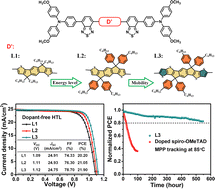A conformally bonded molecular interface retarded iodine migration for durable perovskite solar cells†
Abstract
State-of-the-art n–i–p perovskite solar cells (PSCs) suffer from stability issues due to ionic interdiffusion. Herein, by enlarging the indacenodithiophene π-bridge donor (D′) to combine with the methoxy triphenylamine donor (D) and benzothiadiazole acceptor (A), three linear molecules termed L1, L2 and L3 with a D–A–D′–A–D structure are developed as dopant-free hole transport materials (HTMs). The π-bridge extension with active sites for coordination leverages the intramolecular dipole effect and intermolecular packing effect, resulting in a conformally bonded ultrathin interface with compact and uniform coverage (∼60 nm) to retard iodine migration and protect the buried perovskite. The unencapsulated L3-PSC (ITO/SnO2/perovskite/L3/MoO3/Au) achieved an impressive PCE of 22.61% (certified 21.79%, 0.0525 cm2). Ultrafast laser spectroscopy reveals that L-series molecules have a sequential reduction of photoexcited energy disorder to illustrate the structure–performance–stability relationship. L3-PSC maintains over 85% of the initial efficiency after 500 h at 85 °C maximum power point tracking (MPP) and enables the possibility of using small molecules to stabilize n–i–p PSCs.

- This article is part of the themed collection: Energy & Environmental Science Recent HOT Articles


 Please wait while we load your content...
Please wait while we load your content...